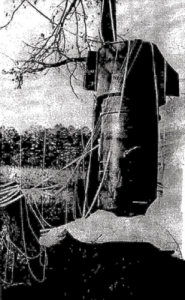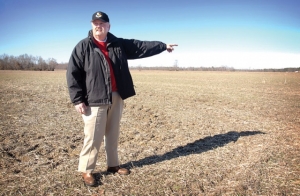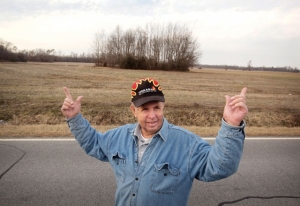The bomb -- One click from Armageddon
By Kenneth Fine and Steve Herring
Published in News on January 23, 2011 1:50 AM

U.S. Air Force photo
A Mark 39 nuclear bomb retrieved after the 1961 Goldsboro B-52 crash. This weapon\'s parachute deployed, resulting in a soft landing and the weapon being recovered intact.

News-Argus/MICHAEL K. DAKOTA
Billy Reeves points to where he lived 50 years ago. Reeves heard the B-52 falling, then turned to look as the aircraft crashed into a field.

News-Argus/MICHAEL K. DAKOTA
Zeb Musgrave points to the spot where 50 years ago a plane carrying two nuclear bombs crashed near Faro. One of the bombs was recovered, but the other remains buried in a Wayne County swamp — and is believed to be inert. Monday is the anniversary of the crash.
In an instant, it was as if Wayne County had never been anything but a thick, red haze hovering above a smoldering crater that stretched for miles.
The land around Ground Zero was ablaze.
All signs of life had been annihilated -- the livestock, wild animals and generations of people who never knew they had seen their last sunset gone in a blast.
The unthinkable had happened.
It was Jan. 24, 1961.
*
Most of the eastern North Carolina residents who awoke to the rising sun 50 years ago Monday had no idea just how close they came to never again opening their eyes.
And had it not been for what many who responded to an Air Force B-52 crash that occurred in the farming community of Faro hours before call "a miracle," their world would have, without question, vanished.
It was just after midnight when Eureka High School senior Billy Reeves ran to his bedroom window to investigate what he can only describe now as an "awful racket like I had never heard before."
And when his mother dropped to her knees in prayer, fear took hold.
"I was scared to death," said Reeves, now 68.
Moments later, the source of the noise appeared -- a deteriorating aircraft making its way toward the ground at an incredible speed.
"I was looking at the plane when it fell," Reeves said. "I saw (it) hit the ground and it exploded twice."
Less than a mile away, the sound of a B-52 impacting the ground left Earl Lancaster with eyes wide open.
"There was a loud noise -- so loud, it woke us up," he said. "I jumped up and headed out."
Moments later, after arriving at the upstart Faro Volunteer Fire Department -- Lancaster was the group's assistant fire chief the night of the crash -- he and another local man made their way toward the source of the explosion in the town's two-seat firetruck.
"We could see it clearly. It just lit up the sky," he said. "We saw the light and knew it was a plane that'd fell. We were some of the very first down there."
But the men had remembered the instructions they were given just a few weeks earlier from a representative from Seymour Johnson Air Force Base.
"'Stay away from it. Protect the property if you can,'" Lancaster remembers the officer telling the group of local firefighters he was addressing during that meeting. "So we got fairly close, but not close enough to get hot."
Even so, the men could see the wreckage.
"It was something to see -- the whole body of the plane laying on the ground," Lancaster said. "Man it just lit up the sky."
And everything around it, he added, was burning.
For more than 40 years — the B-52 first flew in 1954 — the B-52 Stratofortress has been the backbone of the manned strategic bomber force for the United States. The B-52 is capable of dropping or launching the widest array of weapons in the American inventory — gravity bombs, cluster bombs, precision guided missiles and joint direct attack munitions. Updated with modern technology, the B-52 will be capable of delivering the full complement of joint developed weapons and will continue into the 21st century as an important element of our nation’s defenses. Current engineering analyses show the B-52’s life span to extend beyond the year 2040.
General Characteristics of the modern-day B-52:
Primary function: Heavy bomber
Contractor: Boeing
Power plant: Eight Pratt & Whitney engines
Thrust: Each engine up to 17,000 pounds
Length: 159 feet, 4 inches
Height: 40 feet, 8 inches
Wingspan: 185 feet
Speed: 650 miles per hour
Ceiling: 50,000 feet
Weight: Approximately 185,000 pounds empty
Maximum takeoff weight: 488,000 pounds
Range: Unrefueled 8,800 miles
Armament: Approximately 70,000 pounds of mixed ordnance — bombs, mines and missiles.
Crew: Five
Accommodations: Six ejection seats
Unit cost: $53.4 million
Date deployed: February 1955
Inventory: Active force, 85; Reserve, 9
Reeves' father and uncle were also among the first-responders.
But they soon realized that none of the local fire departments on the scene had the equipment needed to fight the aftermath of such a massive disaster.
What they did not yet know, however, was that there was a far more horrifying reality to cope with -- that the B-52 was carrying two Mark 39 nuclear weapons, bombs designed to inflict more than 200 times more damage than those dropped on Japan near the end of World War II.
And so, they simply watched as the biggest fire any of them had ever seen raged ever stronger, thinking all the while about who might have been injured or killed by the blast.
Not far from the site, Zeb Musgrave was on the receiving end of a call he characterizes as "like a dream."
"My mother called me and said a plane had fallen," he said.
And she told him it looked like "the world was on fire," that everything was red and she didn't know what happened.
Rudolph Tyndall got a call, too.
"He said, 'Rudolph, I have got bad news. I think a plane has fell on your daddy's and mama's house.' It scared me to death," he said. "I think what it was was that the fire was burning so huge that at the time, it was probably hard to see anything.
"Naturally, we jumped up, put on our clothes and drove like mad to get out there. When we drove up the hill, I could see the house was still there and they were OK. The plane had fell between my daddy's house and my uncle's house in the field. ... It was amazing. It really was a miracle that this happened and no one got killed in the neighborhood."
But his parents were still shaken by all they heard and saw.
"My daddy said when he looked out the window that all he could see was fire," Tyndall said. "He said he thought the whole world was on fire, and my mama, she said she thought it was the end of the world."
*
According to military reports, the B-52G was on a 24-hour airborne alert mission on the Atlantic seaboard when its captain, Maj. W.S. Tullock, realized that the aircraft had a leak in one of its fuel cells.
Shortly thereafter, the aircraft was directed to land at Seymour Johnson, but as it descended through 10,000 feet on its approach to the airfield, the pilots lost control.
Tullock ordered the crew to eject, which they did at 9,000 feet, but three died as the bomber, which had been carrying those two Mark 39s, crashed.
The two weapons separated from the aircraft as it began to break apart -- five of the six arming devices on one of the bombs became activated, causing them to carry out many of the steps needed to arm themselves. A military analyst determined that the pilot's safe/arm switch was the only one of the six arming devices on the bombs that prevented detonation.
*
Within an hour of the crash, helicopters were flying over the site and Air Force officials were urging those in the area -- and at the scene -- to evacuate.
"A guy from the base, he told everybody to leave -- to go as far as they could. I left right then," Lancaster said. "They told us to git, and we got."
Reeves' father and uncle were instructed to do the same.
"They told everybody, 'Leave. Leave. Leave.' They didn't know how dangerous it was," he said. "The plane was loaded with fuel and two hydrogen bombs."
One of the bombs was found hanging by its parachute in a wooded area off Shackelford Road.
And the other -- its parachute did not open so it free-fell at an estimated speed of 700 miles per hour -- buried itself in a field.
So while those living around the site were being urged to evacuate, military officials launched an effort to recover the buried bomb.
Tyndall remembers the dig.
"In the process of digging, they came in and put up big lights. CP&L put them all the way around the hole," he said. "(The Air Force) worked all night. A lot of people don't know this because they couldn't get in."
Reeves could.
"We wasn't supposed to be, but we boys went up and looked down into the pit," he said. "It had roads going down into it and the Jeeps looked like toys."
But after digging some 20 feet down, the hole began filling with water from nearby Nahunta Swamp.
"The Air Force set up 16 pumps, pumping 20,000 gallons of water an hour, but could still not keep up with the inflow," said Joel Dobson Sr., an employee of the Air Force's Strategic Air Command at the time of the crash who has researched the incident for the past several years.
So despite the fact the the military claims to have recovered many components of that Mark 39, those who live near the site say there is still a bomb in the ground.
*
The U.S. government still collects water samples from 50-foot wells near the site of that 1961 crash.
And to date, nothing but "harmless background radiation has been detected," Dobson said.
"However, those wells are only 50 feet deep, not 180," he said.
But some Faro residents are not convinced that the bomb that buried itself in the earth that morning didn't bring consequences to their community.
"(My mother) died of leukemia. Now, whether anything got out there in the water system and caused that, I don't know," Musgrave said. "She died in '82. Daddy died in '75. There was conversation going on, but I don't remember the nature of it. We were just thankful that it didn't blow us away."
And they were thankful that the sixth arming device -- the safe/arm switch -- prevented detonation.
"It was one notch from having one big lake in eastern North Carolina," Dobson said.
